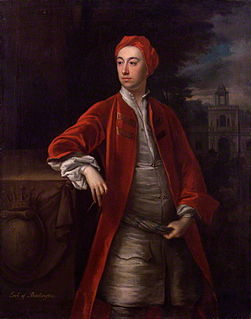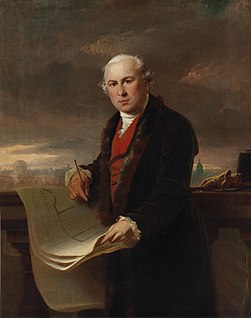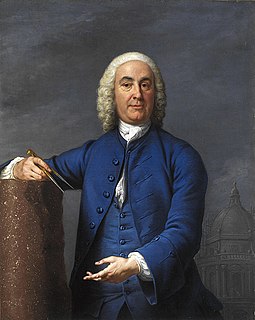This article needs additional citations for verification .(November 2012) (Learn how and when to remove this template message) |
| |||
|---|---|---|---|
The year 1729 in architecture involved some significant events.
This article needs additional citations for verification .(November 2012) (Learn how and when to remove this template message) |
| |||
|---|---|---|---|
The year 1729 in architecture involved some significant events.


Richard Boyle, 3rd Earl of Burlington and 4th Earl of Cork, was an Anglo-Irish architect and noble often called the "Apollo of the Arts" and the "Architect Earl". The son of the 2nd Earl of Burlington and 3rd Earl of Cork, Burlington never took more than a passing interest in politics despite his position as a Privy Counsellor and a member of both the British House of Lords and the Irish House of Lords.

Chiswick House is a Palladian villa in Chiswick, in the west of London, England. A "glorious" example of Neo-Palladian architecture in London, the house was built and designed by Richard Boyle, 3rd Earl of Burlington (1694-1753), and completed in 1729. The house and gardens occupy 26.33 hectares ; the gardens were created mainly by architect and landscape designer William Kent. The garden is one of the earliest examples of the English landscape garden.

Palladian architecture is a European style of architecture derived from and inspired by the designs of the Venetian architect Andrea Palladio (1508–1580). What is recognised as Palladian architecture today is an evolution of his original concepts. Palladio's work was strongly based on the symmetry, perspective, and values of the formal classical temple architecture of the Ancient Greeks and Romans. From the 17th century Palladio's interpretation of this classical architecture was adapted as the style known as "Palladianism". It continued to develop until the end of the 18th century.
The year 1885 in architecture involved some significant architectural events and new buildings.
The year 1936 in architecture involved some significant events.
The year 1753 in architecture involved some significant events.
Sir Edward Lovett Pearce was an Irish architect, and the chief exponent of palladianism in Ireland. He is thought to have initially studied as an architect under his father's first cousin, Sir John Vanbrugh. He is best known for the Irish Houses of Parliament in Dublin, and his work on Castletown House. The architectural concepts he employed on both civic and private buildings were to change the face of architecture in Ireland. He could be described as the father of Irish Palladian architecture and Georgian Dublin.
The architecture of the Republic of Ireland is one of the most visible features in the Irish countryside – with remains from all eras since the Stone Age abounding. Ireland is famous for its ruined and intact Norman and Anglo-Irish castles, small whitewashed thatched cottages and Georgian urban buildings. What are unaccountably somewhat less famous are the still complete Palladian and rococo country houses which can be favourably compared to anything similar in northern Europe, and the country's many Gothic and neo-Gothic cathedrals and buildings. Despite the ofttimes significant British and European influence, the fashion and trends of architecture have been adapted to suit the peculiarities of the particular location. In the late 20th century a new economic climate resulted in a renaissance of Irish culture and design, placing some of Ireland's cities, once again, at the cutting edge of modern architecture.

Richard Cassels, also known as Richard Castle, was an architect who ranks with Edward Lovett Pearce as one of the greatest architects working in Ireland in the 18th century. Cassels was born in 1690 in Kassel, Germany. Although German, his family were of French origin, and descended from the French-Netherlandish 'Du Ry' family, famous for the many architects among their number. A cousin Simon du Ry designed Schloss Wilhelmshöhe in Kassel.

James Gandon (1743–1823) is today recognised as one of the leading architects to have worked in Ireland in the late 18th century and early 19th century. His better known works include The Custom House, the Four Courts, King's Inns in Dublin and Emo Court in County Laois.

James Gibbs was one of Britain's most influential architects. Born in Scotland, he trained as an architect in Rome, and practised mainly in England. He is an important figure whose work spanned the transition between English Baroque architecture and a Georgian architecture heavily influenced by Andrea Palladio. Among his most important works are St Martin-in-the-Fields, the cylindrical, domed Radcliffe Camera at Oxford University, and the Senate House at Cambridge University

Alessandro Maria Gaetano Galilei was an Italian mathematician, architect and theorist, a member of the same patrician family of Galileo.
The year 1723 in architecture involved some significant events.
The year 1699 in architecture involved some significant architectural events and new buildings.
The year 1733 in architecture involved some significant events.
The year 1829 in architecture involved some significant events.

Holkham Hall is an 18th-century country house located adjacent to the village of Holkham, Norfolk, England. The house was constructed in the Palladian style for The 1st Earl of Leicester by the architect William Kent, aided by the architect and aristocrat Lord Burlington.
Events from the year 1729 in Ireland.
Colonel Thomas de Burgh, always named in his lifetime as Thomas Burgh, was an Irish military engineer, architect, and Member of the Parliament of Ireland. He designed a number of the large public buildings of Dublin including the old Custom House (1704–6), Trinity College Library (1712–33), Dr Steevens' Hospital (1719), the Linen Hall (1722), and the Royal Barracks.
| This article about history of architecture is a stub. You can help Wikipedia by expanding it. |